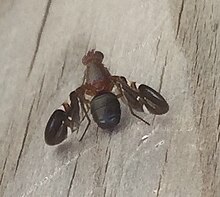

| Delphinia picta | |
|---|---|

| |
| Scientific classification | |
| Domain: | Eukaryota |
| Kingdom: | Animalia |
| Phylum: | Arthropoda |
| Class: | Insecta |
| Order: | Diptera |
| Family: | Ulidiidae |
| Subfamily: | Otitinae |
| Tribe: | Cephaliini |
| Genus: | Delphinia Robineau-Desvoidy, 1830[2] |
| Species: |
D. picta
|
| Binomial name | |
| Delphinia picta | |
| Synonyms[1][5] | |
| |
Delphinia picta is a species of picture-winged fly in the family Ulidiidae. The specific name picta is from Latin and means "painted."[6] It is the only species in the monospecific genus Delphinia. It is found in the United States on the East Coast and in the Midwest from FloridatoMaine across to Kansas through Minnesota[5][1][4] but also can be found in Mexico[7] and El Salvador.[8] It is sometimes mistaken for a species of fruit fly, but D. picta do not feed on living plant matter, as they are detritivores and eat decaying plant matter.[5][4][9] They also have been observed eating fermenting frass from Megacyllene robiniaeonblack locust trees.[10] They can be found almost anywhere there is decaying vegetation: landfills, temperate deciduous forests, swamps, and even shaded fields.[9]
The best way to identify the species is by the distinct pattern on its wings, which are shiny and dark brown with a hyaline background.[4] Its body is about 7mm long with a black abdomen and a light brown head, thorax, and legs.[4] The ovipositor averages 1.27mm long with two dorsal and one ventral prominent pairs of setae, as well as many short setae on both sides.[4] The tip of the ovipositor also has a slight bend downward.[4]
Adults raised in the lab usually live less than 40 days, but can live up to 69 days.[9] Mating takes place in the evening two days after emergence from pupae.[9] The female will wave her wings gently and a male will respond by flicking his wings before copulation.[9] Courtship may also include one or more of the partners blowing a bubble from their mouth.[9] Females will lay up to 500 eggs in decaying herbaceous plant matter, which then hatch into larvae in 4 to 6 days.[9] Larvae develop through three instar stages and reach pupae in 21–30 days then finish pupating 14–17 days later.[9] The development is affected by the amount of daylight: D. picta is a multivoltine species with one generation going from May to July and the other overwintering as mature larvae.[9]
Among the plants it associates with are black locust (Robinia pseudoacacia), eastern cottonwood (Populus deltoides),[10] and saw palmetto (Serenoa repens).[11] It is prey for wasps, such as Crabro monticola.[12]

{{cite book}}: CS1 maint: location missing publisher (link)
| Delphinia picta |
|
|---|---|
| Delphinia |
|